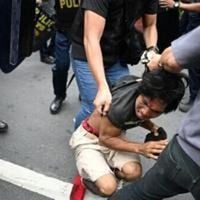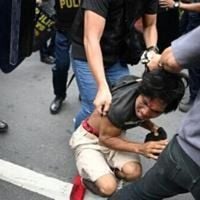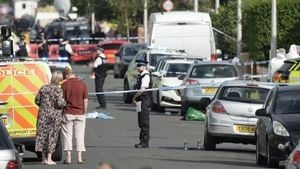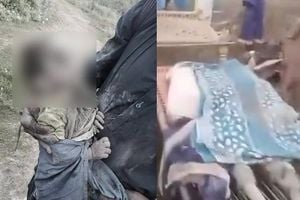Manila was thrust into chaos on Sunday, September 21, 2025, as anti-corruption protests that began peacefully erupted into violence near the Philippine presidential palace. While more than 33,000 demonstrators gathered at historic landmarks to voice outrage over a sweeping corruption scandal, a separate group clashed with police in scenes that left the capital reeling and the nation’s leadership under renewed scrutiny.
According to the Associated Press, the day’s events unfolded in two sharply contrasting acts. At one end of the city, thousands of Filipinos—students, activists, clergy, and everyday citizens—assembled at a park and democracy monument. Their cause? To demand accountability for billions of pesos allegedly siphoned from flood-control projects by lawmakers, government officials, and construction magnates. The scandal, which President Ferdinand Marcos Jr. himself described as “horrible” in his July state of the nation address, has ignited public fury in a country all too familiar with political graft.
But the mood darkened dramatically just blocks away from the seat of power. Police reported that about 100 people, many wielding clubs and some waving black flags emblazoned with a skull and crossbones, launched a rampage through heavily guarded roads and bridges leading to the Malacañang presidential palace. The group hurled rocks, bottles, and fire bombs at officers, blocked key thoroughfares, and vandalized property. Tear gas filled the air as authorities struggled to regain control. By nightfall, 49 suspects had been arrested, and the toll on law enforcement was heavy: around 70 Manila police officers were reported wounded.
“I feel bad that we wallow in poverty and we lose our homes, our lives and our future while they rake in a big fortune from our taxes that pay for their luxury cars, foreign trips and bigger corporate transactions,” student activist Althea Trinidad told the Associated Press. Trinidad, who hails from Bulacan—a flood-prone province north of Manila—spoke for many who see the scandal as not just a political crisis, but a betrayal of the nation’s most vulnerable.
The violence forced schools across the city to close for the day, a stark reminder of how deeply the scandal’s shockwaves have penetrated daily life. Police responded with a show of force, deploying tear gas to disperse the attackers. The group, some of whom had sprayed graffiti on walls, toppled steel posts, shattered glass panels, and even ransacked the lobby of a budget inn along a bustling road lined with universities and restaurants, eventually scattered into the night. The identities and affiliations of the attackers remained unclear hours after the melee, with authorities unable to confirm whether they had participated in the peaceful rallies before turning to violence.
In a statement following the arrests, Manila police declared that the situation had been “contained” but issued a stern warning: violence and vandalism would not be tolerated. The uncertainty surrounding the attackers’ motives and connections has left many in Manila uneasy, with rumors and speculation swirling about possible agitators seeking to discredit the broader protest movement.
Meanwhile, the peaceful demonstrators maintained a resolute focus on their core demand: an end to the culture of impunity that has allowed corruption to fester at the highest levels. The protests were sparked by revelations that lawmakers, government officials, and construction company owners pocketed huge kickbacks from public works projects meant to protect communities from the country’s frequent floods and typhoons. The scale of the alleged graft is staggering—over 9,855 flood-control projects, valued at more than 545 billion pesos (about $9.5 billion), are now under investigation by an independent commission established by President Marcos Jr.
Public outrage reached a boiling point when a wealthy couple, who ran several of the construction firms implicated in the scandal, flaunted their fleet of European and American luxury cars on national television. Among the vehicles was a British luxury car with a price tag of 42 million pesos (approximately $737,000)—a purchase the couple reportedly justified because it “came with a free umbrella.” For many Filipinos, images of such extravagance were a bitter pill, especially as communities in provinces like Bulacan continue to suffer from inadequate flood defenses.
Cardinal Pablo Virgilio David, head of the Catholic Bishops’ Conference of the Philippines, urged calm and unity in a statement that echoed through the crowds and across social media. “Our purpose is not to destabilize but to strengthen our democracy,” he said, calling on the public to demonstrate peacefully and demand accountability from their leaders. His words reflected a widespread sentiment: that the fight against corruption must not descend into chaos, but instead serve as a catalyst for genuine reform.
President Marcos Jr., who has made anti-corruption a centerpiece of his administration, was reportedly in the presidential palace during the unrest, though this could not be independently confirmed. In his July address, Marcos did not mince words, decrying the “horrible” scale of corruption and accepting the resignation of his public works secretary. The president’s decision to form an independent commission signaled an intent to pursue the investigation vigorously, but critics argue that only time will tell whether those responsible will truly be held to account.
As the dust settled over Manila, the city was left to grapple with the aftermath. Streets once filled with hopeful chants and banners were marred by the scars of confrontation—broken glass, toppled posts, and graffiti marking the flashpoints of conflict. For many, the day’s events underscored the delicate balance between passionate protest and public order, and the ever-present risk that legitimate grievances can be overshadowed by violence.
Yet the core message of the protests rang clear: Filipinos are demanding a government that serves the public good, not private interests. The outpouring of anger and frustration, both in the streets and online, has put renewed pressure on the nation’s leaders to deliver on promises of transparency and justice. As investigations into the flood-control projects continue, the eyes of the country—and indeed, much of the world—will be watching to see whether the Philippines can turn this moment of crisis into a turning point for its democracy.
For now, Manila’s streets have quieted, but the calls for accountability echo louder than ever. The events of September 21 stand as a stark reminder: the fight against corruption is far from over, and the path to real reform is as fraught as it is urgent.





